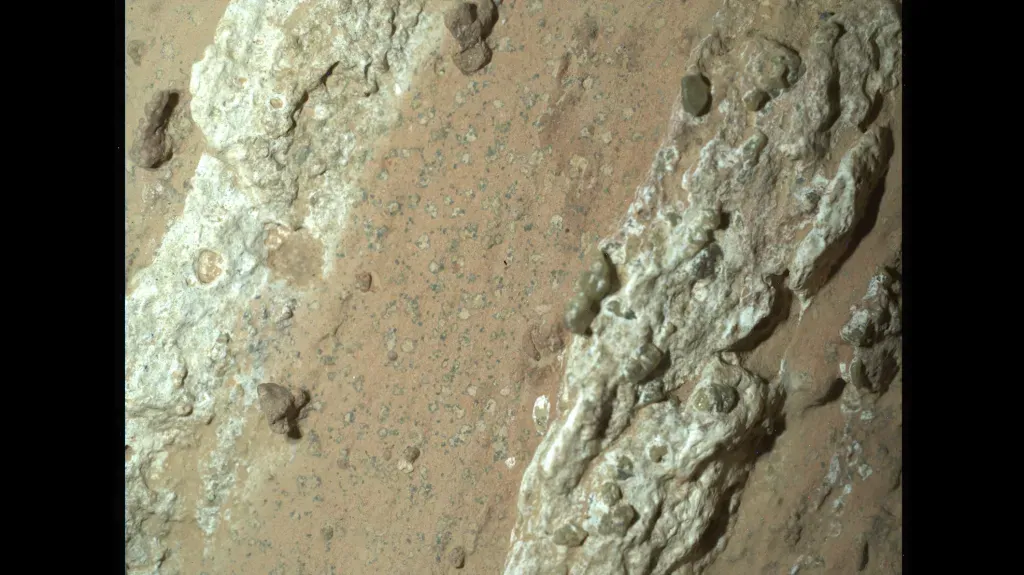Life on Mars?
NASA’s newest Mars rocks may hold the strongest hints of ancient life yet

Quick Take
NASA’s Perseverance rover just analyzed speckled mudstones in the Bright Angel area of Neretva Vallis that contain minerals and textures which, on Earth, often form with microbial help. It is not proof of life, but it is the most compelling target so far. Final answers likely require returning these samples to Earth. Reuters+2The Guardian+2
What NASA found
- Perseverance examined light-toned, speckled mudstones in the Bright Angel formation along the ancient river channel that once fed Jezero Crater’s lake. Team papers and briefings point to greenish specks and nodules consistent with minerals like vivianite and greigite, plus organics, all seen inside sediments that formed in water. These combinations are classic habitats for microbes on Earth. The Guardian+2Space+2
- A related rock nicknamed Cheyava Falls shows “leopard-spot” patterns and chemistry the team flagged in 2024 as especially interesting for past habitability. Bright Angel has been a prime science target for more than a year.
- Jezero is an ancient lake basin with deltas and inflow channels. That watery past is why NASA sent Perseverance there. Reuters
Why this matters
- Minerals such as vivianite and greigite can arise when iron, sulfur, phosphorus, and carbon cycle together in waterlogged muds. On Earth, those cycles are often driven or stabilized by microbial communities. Finding these minerals inside fine lake sediments on Mars raises the odds that the rocks captured chemical fingerprints of ancient biology. The Guardian+1
- Multiple reputable outlets are calling this the strongest hint so far in the Mars life hunt. That framing reflects the context and the mineral-organic combo, not a definitive biosignature claim. Reuters+2The Washington Post+2
What we still do not know
- Non-biological processes can sometimes make similar textures and minerals. Distinguishing biology from geology requires lab-grade tests that are not possible on Mars today. The Guardian
- The clean answer likely needs Mars Sample Return. NASA just reaffirmed the importance of returning Perseverance’s cached cores, though program timing and budget are in flux. Perseverance has collected about 30 samples so far and continues to inspect new targets. NASA
The receipts
- Reuters: “NASA rover finds potential sign of ancient life in Martian rocks.” Reuters
- The Guardian: “Unusual compounds in rocks on Mars may be sign of ancient microbial life.” The Guardian
- Washington Post: “Clearest sign of life we’ve ever found on Mars” coverage of speckled mudstones. The Washington Post
- PBS NewsHour: “Strongest hints yet of potential signs of ancient life.” PBS
- NASA JPL: Background on the “leopard-spot” Cheyava Falls rock.
- NASA: Briefing notice and current sample count context. NASA
What if
What if these textures and minerals really came from ancient microbes?
- Then Mars had stable, chemical-rich waters long enough for life to emerge and leave traces we can still read. The big question shifts from “Did life start?” to “How long did it persist and where did it go?”
- Earth would not be unique. Two worlds in one solar system hosting life would strengthen the case that life is common in the universe.
- The scientific priority becomes targeted sample return and drilling into similar lake-margin mudstones elsewhere on Mars to map the extent of past biospheres. NASA
- If Earth and Mars is teaming with life, what does that mean for the rest of our universe
What if there was a ancient civilization on Mars?
- Homegrown Martians. A culture that rose during a wetter era, then retreated underground or vanished as the planet dried.
- Visitors turned settlers. A stranded expedition or outpost from elsewhere that left brief, localized traces before the climate failed.
- Billions of years... before Earth even started developing life
Pushback and cautions
- Abiotic pathways can mimic bio-textures. Without isotopic ratios, complex molecular patterns, or cell-like microstructures seen under powerful microscopes on Earth, the team will keep a conservative stance. The Guardian
- Methane remains murky. Some studies even cast doubt on past methane detections, so not every “life hint” on Mars holds up the same way. Today’s story stands on minerals and organics in water-laid mud, not methane plumes. aeronomie.be


Comments ()